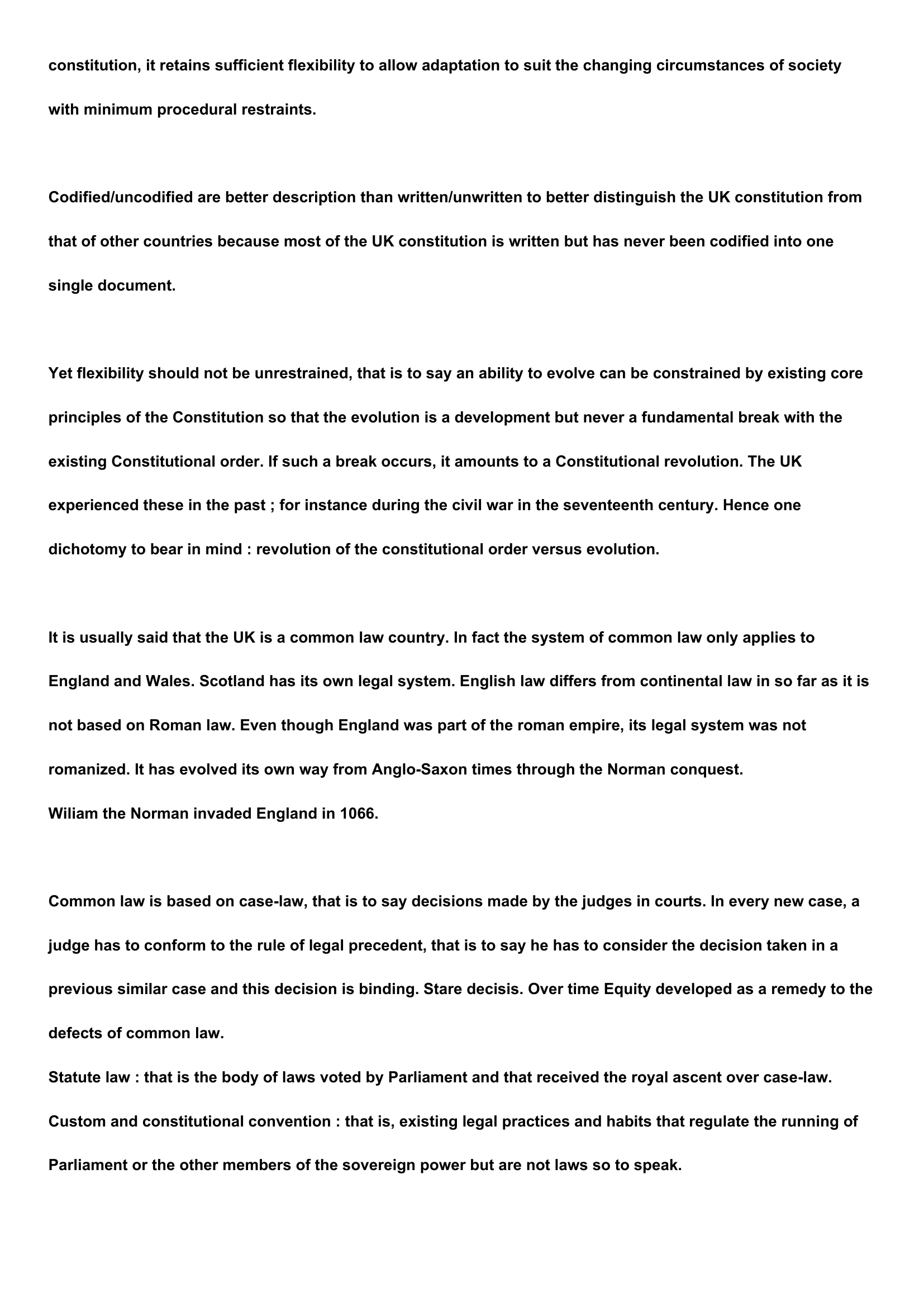
TD Fondements historiques du droit constitutionnel en GB Introduction to the foundation of British constitutionnal law. Alexis de Tocqueville : « L'Angleterre n'a pas de Constitution «. He meant that the UK does not have a written Constitution in the french sense of the term. In fact the UK is one of the very few countries in the world to have no such Constitution. Of course it doesn't mean that there are no written rules in the UK but it means that there isn't a single called a constitution, which takes a special presidia to amend. Similarly in France since 1958 there's been a special body called the Conseil Constitutionnel in charge of checking the conformity of a law with the constitutional principles. There is no such thing in the UK. The term Constitution has 2 meanings : it is only in the broad sense rather than in the narrow of a single written document setting out the constitutional framework that a British Constitution can be said to exist at all. In its broad sense it can be defined as “the system of laws, customs and conventions which define the composition and powers of organs of the state and regulate the relations of the various state organs to one another and to the private citizen” The Constitution of the UK has evolved into its modern form over many centuries. Unlike the common codified constitution, it retains sufficient flexibility to allow adaptation to suit the changing circumstances of society with minimum procedural restraints. Codified/uncodified are better description than written/unwritten to better distinguish the UK constitution from that of other countries because most of the UK constitution is written but has never been codified into one single document. Yet flexibility should not be unrestrained, that is to say an ability to evolve can be constrained by existing core principles of the Constitution so that the evolution is a development but never a fundamental break with the existing Constitutional order. If such a break occurs, it amounts to a Constitutional revolution. The UK experienced these in the past ; for instance during the civil war in the seventeenth century. Hence one dichotomy to bear in mind : revolution of the constitutional order versus evolution. It is usually said that the UK is a common law country. In fact the system of common law only applies to England and Wales. Scotland has its own legal system. English law differs from continental law in so far as it is not based on Roman law. Even though England was part of the roman empire, its legal system was not romanized. It has evolved its own way from Anglo-Saxon times through the Norman conquest. Wiliam the Norman invaded England in 1066. Common law is based on case-law, that is to say decisions made by the judges in courts. In every new case, a judge has to conform to the rule of legal precedent, that is to say he has to consider the decision taken in a previous similar case and this decision is binding. Stare decisis. Over time Equity developed as a remedy to the defects of common law. Statute law : that is the body of laws voted by Parliament and that received the royal ascent over case-law. Custom and constitutional convention : that is, existing legal practices and habits that regulate the running of Parliament or the other members of the sovereign power but are not laws so to speak. Community law : since 1973 it has taken precedent over municipal law. The pillars of the constitution : the fundamental texts that might be obsolete but still serve as referencies. Magna Carta 1215, the Act of Supremacy (Henry 8th passed it in 1544 when he decided to break with Rome, and became head of the Church), a petition of rights in the XVIIth century, Habeas Corpus.... A.V. Dicey “The Law of the Constitution” 1885 “Constitutional law as the term is used in England appears to include all rules which directly or indirectly affect the distribution of the exercise of the sovereign power in the State. Hence it includes all rules which define the members of the sovereign power, all rules which regulate the relation of such members to each other, or which determine the mode in which the sovereign power or the members thereof, exercise their authority” As Dicey defines it and as legal scholars admit it, there are two main branches of Constitutional law ; first, laws – that is to say, a set of rules enacted by statute or derived from the mass of custom, traditions or judge-made decisions : common law ; second, conventions of the Constitution – that is to say, habits, practices that may regulate the conduct of the several members of the sovereign power of the ministry or of other officials of the sovereign power, but are not properly laws since they are not enforced by the courts. There is no such thing as a single text called the Constitution, but a whole set of laws and rules that regulate political power. In fact you may say that the british constitution is a historical constitution in the sense that it is the product of a century-long historical process. That is why we will study the key-texts that led to the present organization of the various bodies that compose the sovereign power, their scope (?) for action and their interruption. The course will thus examine the potential relevant of historical evidence to the evolution of some constitutional issues. First, the protection of individual rights, then the role of Parliament and its relationship with the executive, that is to say an understanding of the history of the Westminster Parliament, its constitutional role and the development of the parliamentary executive cast light upon the modern institutions and their respective roles under the Constitution. The role of a hereditary at apex of the UK is continuously subject to debates. It should be noticed right away that it is only in the 13th century that a legislature separate from the person of the King and his close advisers began to emerge, and it was later still by fits and starts that it developed any degree of independence from the king. Governments until comparatively recent times was centered on the king. Only in the XVIIth century, following a civil war the execution of one king, a period of republican rule, a restoration of a monarchy and a deposition of a second king, did legislative power passed finally from the king alone to the king and Parliament. Who is reffered to as “we” from the text? Explain the references to “the quarrel...between us and our barons”. Paragraphe 14 : qu'entend-on par “letters of summons” Paragraphe 34-35: what is “writ” ? What categorizes of English men are mentioned in the document ? List the main liberties they are granted. In what terms are these liberties defined ? Explain the reference to the “english church” paragraphe 1 et dernier paragraphe. The Magna Carta The rule of law has long been recognized as a central feature of the English Constitution. That is government must operate according to the Law. It thus offers a basic minimum protection for individuals against the government. It is difficult to imagine the modern “UK Constitution” without this principle at its heart and the first steps towards it can be traced backed to 1215 because the Magna Carta. The Great Charter thought to establish the rights of subjects against authority and maintained the principle that authority was subject to law. J.C.Holt : 1992 : the magna charta is not but a penitentiary one that is to say that the record of the transaction agreed the at Runnymede. W.R. Warren : He claims that it is an unrewarding document for the general reader; you realize that it bristles with the technicalities of feudal law and when these are cleared away, its provisions seem very general and basic. There is no high-sounding statements of principles or clearly defined political theory within its terms. It could be divided into 6 categories of provisions: those relating to freedom of the English church, those concerning John's lordship over his barons, determining the services and payments due to him, those on administrative matters, including the effective functioning of the common law courts, those granting concession to the English towns, those creating machinery for enforcing the Charta, (25 barons chosen to form the Counsel), and those of political importance. We could add that it is largely through the provisions of 39 and 40 that Magna Carta has come to symbolize the law, as it marked one of the earliest attempts to impose the limitation of Law on a ruler's sovereign authority. These two chapters also establish the basic principles that the rule of law ensures personal liberty ; in other words, Magna Carta was a standing condemnation of the rule of arbitrary will. An appeal to it throughout the ages has been a short-hand way of proclaiming the rule of law. Even though it originated as merely an attempt to protect baronial interests, by establishing the principles inherent in the rule of law, Magna Carta left a legacy for individuals of future ages to ensure that their governments acted according to the Law and legal processes. The country was on the brink of Civil War ; and feelings of rebellion were s...



































